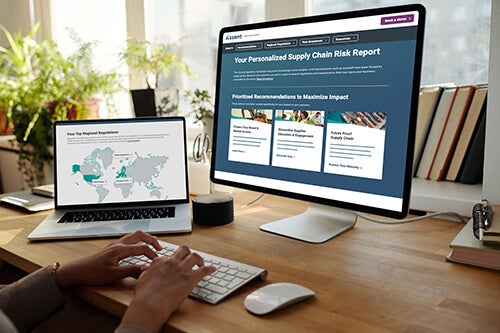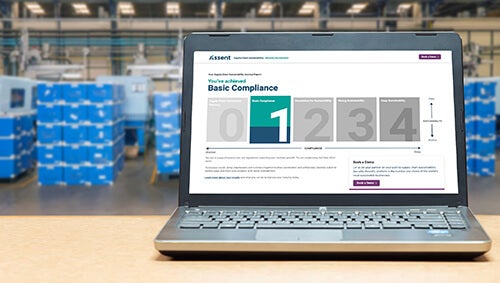Our regulatory subject matter experts help a range of stakeholders solve compelling regulatory challenges associated with supply chain data management. We compile their insights to help educate compliance professionals through content, webinars and events. They also provide advice directly to Assent’s clients. Here are the top five questions our Regulatory team has responded to over the past month.
Question: The European Union (EU) Medical Device Regulation (MDR) establishes rules about the presence of certain substances. What are the regulated substances and where can the list be found?
Answer — Raj Takhar: The list of EU MDR regulated substances can be found in Chapter II Section 10.4 of Annex I of EU MDR. This section of the text outlines three component lists:
- Substances which are “…carcinogenic, mutagenic or toxic to reproduction (‘CMR’), of category 1A or 1B, in accordance with Part 3 of Annex VI to Regulation (EC) No 1272/2008 of the European Parliament and of the Council.”This refers to the European Commission’s Classification, Labelling, and Packaging (CLP) Regulation, whose Annex VI provides a detailed list of chemicals. Category Codes allow identification of substances known to be carcinogenic, mutagenic, or toxic to reproduction.
- Substances with “…endocrine-disrupting properties…identified either in accordance with the procedure set out in Article 59 of Regulation (EC) No 1907/2006 of the European Parliament and of the Council.”This refers to the EU Registration, Evaluation, Authorisation and Restriction of Chemicals (REACH) Regulation, specifically substances on the REACH SVHC Candidate List known to have endocrine-disrupting properties, as indicated in the “Reason for inclusion” field in the List.
- Substances with “…endocrine-disrupting properties…pursuant to the first subparagraph of Article 5(3) of Regulation (EU) No 528/2012.”This refers to Article 5 (Item 3) of the EU Biocidal Properties Regulation (BPR). The European Chemicals Agency (ECHA)’s Endocrine Disruptor Assessment List gives assessment status for substances considered to be potential endocrine disruptors under EU BPR or the REACH Regulation.
Additionally, EU MDR requires manufacturers of implantable devices to perform full material disclosure (FMD) reporting for those products.
Question: Many regulations require annual documentation updates. The REACH SVHC Candidate List is updated twice annually. Does this mean documentation must be updated twice per year or is once per year sufficient?
Answer — Valerie Kuntz: Under Article 33(1) of the REACH Regulation, the presence of SVHCs above threshold in articles requires communication to the next level in the supply chain immediately upon an SVHC being added to the Candidate List. There is also a requirement to provide SVHC information to consumers within 45 days of a request from the consumer (Article 33(2)).
Only collecting this information annually could prevent you from meeting these requirements.
Companies should also be aware of the Substances of Concern In articles as such or in complex objects (Products) (SCIP) database, which was established by the Waste Framework Directive. Under the new requirements, companies that operate in the EU and import or manufacture articles with SVHCs over threshold per Article 33 of the REACH Regulation must enter the SVHC, article and product information into the database. This information will need to be available and entered into the database by January 5, 2021. This requirement will further enforce that the communication duties established under the REACH Regulation are properly followed.
Question: Sometimes suppliers send responsible minerals declarations that are not made using the Conflict Mineral Reporting Template (CMRT). Is the CMRT the only acceptable form of documentation or are other document types allowable?
Answer — Jared Connors: Other forms of documentation are allowable; companies are not required to use the CMRT. For instance, affirmation statements can be used in lieu of CMRT documentation to demonstrate compliance.
However, the documentation suppliers use must meet industry expectations in order to be acceptable. Unfamiliar documentation may be more difficult to interpret and ingest into IT systems based on consistent data structures, so be sure to read responses carefully and take time to understand the information received.
Question: Should products be labeled according to the component you create or a customer’s end product under China Restriction of Hazardous Substances (RoHS)?
Answer — Valerie Kuntz: Under China RoHS, labeling is only required for the final product. However, companies are still responsible for communicating the presence of the six listed substances, including their location in the product, to their customers. If the finished product is in scope of the product types defined in the catalog published by China’s Ministry of Industry and Information Technology — officially known as the Standard Achieving Management Catalogue for the Restriction of Hazardous Substances in Electrical Appliances and Electronic Products — the substance amounts must be below threshold or the product must be compliant by exemption.
There are several different label types in use under China RoHS. The regulation requires all electrical and electronic products (EEPs) placed on the market in China to be evaluated for the presence of the six listed substances and labeled accordingly:
- Products that contain a listed substance over the threshold must apply an EFUP (Environmentally Friendly Use Period) label. This is an orange number in a circle of two orange arrows; the number corresponds to the number of years the product can be safely used before risking exposure to harmful substances.
- Products that do not contain any of the listed substances over threshold may use a “Green E” label rather than an EFUP label. This is a green lower-case “e” in a circle of two green arrows.
Question: Under the EU RoHS Directive, is the product category determined by the current product manufactured or the final product? For example, if you produce a cellular modem, but a customer uses it as a component in an electric metering product.
Answer — Valerie Kuntz: The final product category is the category that applies. If the cellular modem is sold as a stand-alone item, it would be considered a Category 3 product. Because it is being used in another product, however, that product’s category is the applicable category.
For more questions and answers, visit the last edition of Assent’s Ask the Experts blog.
Assent’s regulatory subject matter experts frequently participate in events such as webinars to educate compliance professionals. They also inform our clients’ regulatory programs. To learn more, contact us today.







